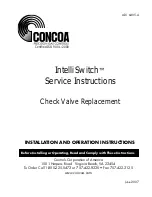
--
√
Always remove all empty cylinders from a manifold before connecting full cylinders.
√
Always test cylinders to be sure they are full before connecting to a manifold.
√
NOTE: Use of Teflon
®
lined pigtails for oxygen installations is not recommended unless they are equipped with a Distance Volume
Piece (DVP). Components in the manifold system can create a dead end passage. The combination of a dead end passage
coupled with a rapid pressurization may lead to adiabatic compression of the contained oxygen and subsequent failure of the
pigtail by ignition.
√
All gas distribution piping systems must meet appropriate industrial standards for the intended service, and must be thoroughly
cleaned before using.
√
Keep all cylinders away from any source of high temperature (not over 120° F, 50° C) or possible fire hazards. High-pressure gas
contained in a closed cylinder becomes increasingly dangerous when exposed to high temperature because pressure increases
and the strength of the cylinder decreases.
√
No smoking should be permitted near oxygen nitrous oxide, flammable gases and flammable mixtures and in area where cylinders
are stored.
√
Where oxygen or nitrous oxide is used, the manifold and cylinders must be kept clean. No oil, grease, or combustible substances
should come in contact with oxygen or nitrous oxide storage or handling equipment. Such materials in contact with oxygen or
nitrous oxide are readily ignitable and when ignited, will burn intensely.
√
Never lift gas cylinders with a magnetic lifting device.
√
Never use an open flame when leak testing.
√
Keep all cylinders away from any source of high temperature (not over 120° F, 50° C) or possible fire hazards. High-pressure gas
contained in a closed cylinder becomes increasingly dangerous when exposed to high temperature because pressure increases
and the strength of the cylinder decreases.
√
No smoking should be permitted near oxygen nitrous oxide, flammable gases and flammable mixtures and in area where cylinders
are stored.
√
Where oxygen or nitrous oxide is used, the manifold and cylinders must be kept clean. No oil, grease, or combustible substances
should come in contact with oxygen or nitrous oxide storage or handling equipment. Such materials in contact with oxygen or
nitrous oxide are readily ignitable and when ignited, will burn intensely.
√
Never lift gas cylinders with a magnetic lifting device.
√
Never use an open flame when leak testing.
Comply with all safety rules and precautions of the following:
1. American National Standards Institute standard Z49.1 or Safety in Welding and Cutting, American Welding Society, 2501 NW
Seventh Street, Miami, FL 33125.
2. N.F.P.A. Standard 51, Oxygen-Fuel Gas Systems for Welding and Cutting, N.F.P.A., 470 Atlantic Avenue, Boston, MA 02210.
3. N.F.P.A. Standard 51B, Cutting and Welding Processes, (see Address in #2)
4. CONCOA Publication ADE 872, Safety Precautions in Welding and Cutting.
5. Local ordinances.
6. O.S.H.A.
7. C.G.A. Pamphlet C-4, American National Standard Method of Marking Portable Compressed Gas Containers to Identify the Material
Contained.*
8. C.G.A. Pamphlet G-4, Oxygen-Information on the properties, manufacture, transportation, storage, handling, and use of oxygen.
9. C.G.A. Pamphlet G-4.1, Equipment Cleaned for Oxygen Service.
10. C.G.A. Pamphlet C-4.4, Industrial Practices for Gaseous Oxygen Transmission and Distribution Piping Systems.
11. C.G.A. Pamphlet G-5, Hydrogen - Information on the properties, manufacture, transportation, storage, handling, and use of hydrogen.
12. C.G.A. Pamphlet G-6, Carbon Dioxide - Information on the properties, manufacture, transportation, storage, handling, and use of
carbon dioxide.
13. C.G.A. Pamphlet G-6.1, Standard for Low Pressure Carbon Dioxide Systems at Consumer Sites.
14. C.C.A. pamphlet P-1, safe handling of compressed gases in containers.
15. C.G.A. Safety Bulletin SB-2, Oxygen Deficient Atmospheres.
*C.G.A. pamphlets can be obtained from the Compressed Gas Association, 1235 Jefferson Davis Highway, Arlington, VA 22202-3239, (703)
979-0900. Publications: (703) 979-4341. Fax: (703) 979-0134.
REMOVAL
1. Disconnect AC Power from unit.
2. Shut off all pressure to unit and bleed off any pressure remaining in the lines and regulators.
3. Using a small flat blade screwdriver, remove the plug from the center of the Outlet Pressure adjustment knob.
4. Remove the nut holding the knob to the shaft. DO NOT attempt to remove or adjust the nuts on the shaft underneath the knob.
5. Remove large nut and washer holding the bonnet to the cover.
6. Remove the four (4) screws holding the cover to the enclosure.
7. Carefully pull cover away from enclosure.
8. Disconnect all the cables connected to the Control Board. It is recommended that each cable be marked identifying its location
before removing. Use Figure 1 as a guide. The three (3) connectors coming from the transducers and the two connectors coming
from the solenoids have locking tabs. Squeeze the locking tab on each connector to remove it from the board. Carefully remove
the other connectors from the board.
9. Place the front panel in a secure location being careful not to scratch the front label.
10. The check valves are located on either side of the delivery regulator. Using a hex wrench, remove the large brass check valve retainer.
11. Carefully reach into the body and remove the pin and spring. If debris is found it should be removed.
Содержание IntelliSwitch Maniflex 628 Series
Страница 6: ... THIS PAGE INTENTIONALLY LEFT BLANK ...








